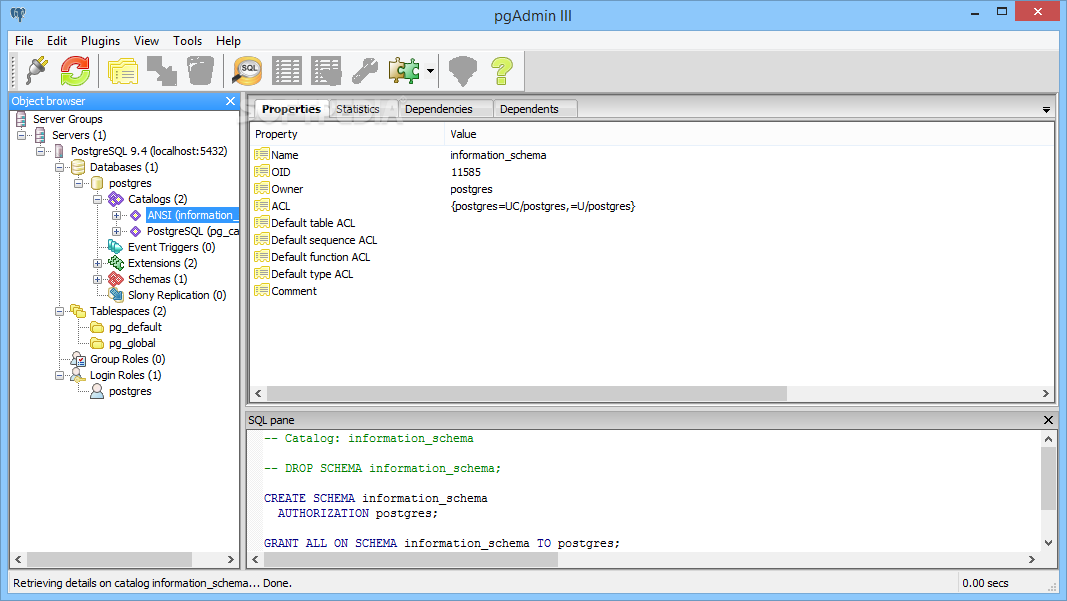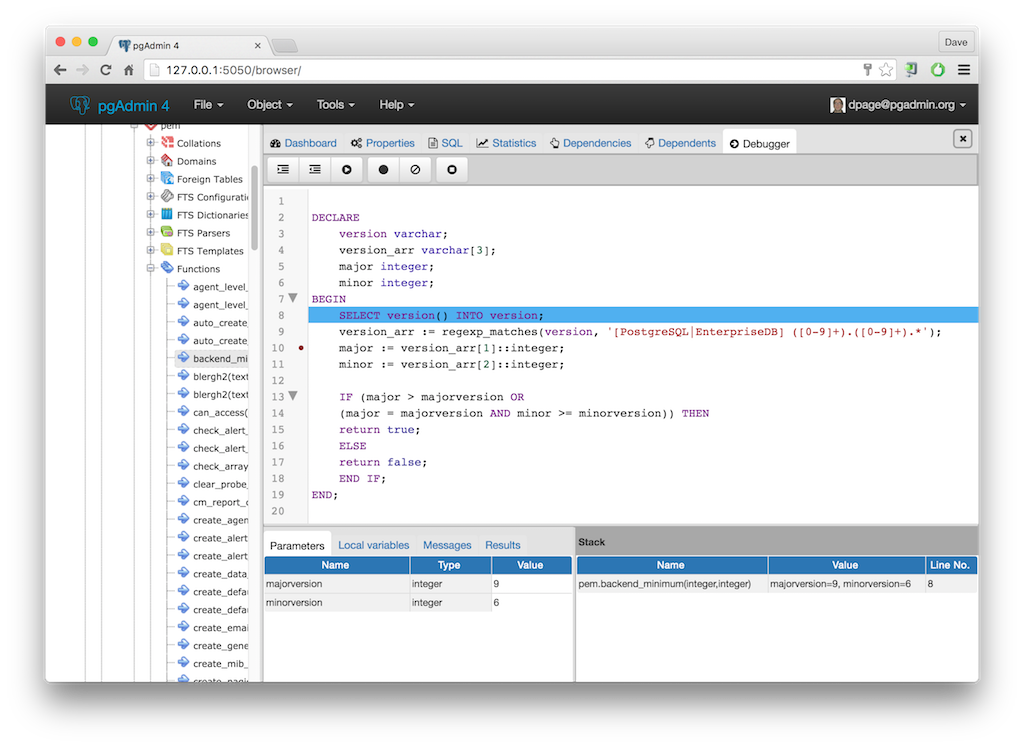- Download Postgresql 9.5
- Postgresql Mac Download
- Mac Os Download Postgres 9.6 Jdk
- Mac Os Download Postgres 9.6 64-bit
How To Install Postgresql On Mac
The best place to get the latest binaries for both PostgreSQL and PostGIS is the PostgreSQL Yum repository Refer to Installing PostGIS 3 and PostgreSQL 12 on CentOS 8 repository RPM for your distribution, download and install it. Ubuntu / Debian. How to use homebrew to downgrade postgresql from 10.1 to 9.6 on Mac OS closed Ask Question Asked 2 years, 8 months ago. Active 1 year, 5 months ago. My mac has postgresql 10.1 on it, and I need 9.6 for my work website to function on my local machine. Can't find easy instructions on how to uninstall or downgrade to 9.6.
It is free and open source. Also you can get it from the GitHub mirror. Enterprise Edition 7.2.0. Released on September 7, 2020 EE version web site: dbeaver.com Trial version is available. Windows 64 bit (installer) Windows 64 bit (zip) Install from Microsoft Store; Chocolatey package; Mac OS X. Mac OS X (installer) Mac OS X (dmg) Mac. Postgres.app is the quickest, easiest way to start working with PostgreSQL on your Mac. It is strongly advised that you do not use Postgres.app in a production environment.However, for learning about PostgreSQL and using extensions such as PostGIS, Postgres.app makes server installation and set up a. How To Install PostgreSQL 9.6 on CentOS 7 / RHEL 7 For more explanation visit our site: http://yallalabs.com/linux/how-to-install-postgresql-9-6-on-centos-7. It should install the latest version of Postgres available via Homebrew. Pretty easy, right? Upgrading Postgres via Homebrew. Ok, so let’s say you have to upgrade postgres. I had to follow these steps when I was upgrading to Postgres 9.6. Step 1 – Turn off Postgres. The first step is to turn off the postgres service if it’s running in the.
I started off programming Ruby on Rails applications on a Windows machine with an Ubuntu virtual machine running on top. But when I got my first job at a startup in California, I received a brand new shiny Macbook laptop.
I had never used a Mac before as I considered them overpriced relative to a desktop I could setup with Linux. But since that’s what I was given, that’s what I was used. One of the first things I had to do is figure out how to get Postgres up and running.
Eventually, I had to learn a good way to upgrade it as well. At my first job, I found that using Heroku’s Postgres app. At my next job, I used the homebrew package manager since that’s how our team used it.
So what follows is a mini-guide I put together on how to install postgresql on Mac as well as how to upgrade it with homebrew.
Now if you want to use Heroku’s Postgres app, it’s pretty easy and is a good alternative to homebrew.
Installing Postgres via Homebrew
This guide assumes that you have homebrew installed. If you don’t, you can find some instructions here.
Once you do that, all you have to do is issue the following command in your terminal:
$ brew install postgres
It should install the latest version of Postgres available via Homebrew. Pretty easy, right?
Upgrading Postgres via Homebrew
Ok, so let’s say you have to upgrade postgres. I had to follow these steps when I was upgrading to Postgres 9.6
Step 1 – Turn off Postgres
The first step is to turn off the postgres service if it’s running in the background.

$ brew services stop postgresql
Step 2 – Upgrade
Next, we’ll use homebrew to upgrade it to the latest version.
$ brew update && brew upgrade postgresql
Step 3 – Switch
Finally, we’ll switch to the new version using the following command.
brew switch 9.6.1
You’ll see output like the following:

Step 4 – Ensuring Postgresql Starts Automatically At Startup (optional, but makes your life easier)
Now to ensure postgres starts automatically every time you start your Mac, you’ll need to do some extra setup.
I got the following setup from this blog post at tunnelsup.
Step A – You’ll need to setup LaunchAgents
Create the directory ~/Library/LaunchAgents if it doesn’t exist already.
Step B – Copy the plist file to ~/Library/LaunchAgents/
There’s a plist file that comes with the postgres install from homebrew.
When upgrading to 9.6.2, my plist was at /usr/local/Cellar/postgresql/9.6.2/homebrew.mxcl.postgresql.plist.
Copy the plist file to the LaunchAgents directory.
cp /usr/local/Cellar/postgresql/9.3.4/homebrew.mxcl.postgresql.plist ~/Library/LaunchAgents/
Step C – Load launchctl
Now use launchctl to load the file using this command:
$ launchctl load -w homebrew.mxcl.postgresql.plist
You can also use a ruby gem called lunchy. I haven’t tried it but this blog post describes the process.
General Troubleshooting Tips And Useful Commands
The following command will show you if you have multiple versions of postgres installed.
Download Postgresql 9.5
$ brew info postgresql
This troubleshooting gist describes how to migrate data from one version of Postgres to another.
Troubleshooting Guide for Rails developers
This part gives you some common troubleshooting tips if you’re a Rails developer.
Since I primarily use Postgres for Ruby on Rails work, when I was upgrading I had a connection issue described below.
If you get a connection issue with a message such as the following:
Postgresql Mac Download
Then try running this in your terminal:
If you see the above “FATAL…”, then issue the following commands:
WARNING: Before you issue the following commands, please make sure you back up your old local Postgres data if you need it. See the gist referenced in the General Troubleshooting Tips And Useful Commands section.
Mac Os Download Postgres 9.6 Jdk
$ rm -rf /usr/local/var/postgres && initdb /usr/local/var/postgres -E utf8
Mac Os Download Postgres 9.6 64-bit
After running the above rm and initdb commands, you should see something similar to the following.
Summary
If you want to install Postgres via homebrew, follow the steps above. Make sure you backup your local data if you need it so you don’t accidentally erase something you need to keep. Other than that, let me know if you have any issues in the comments.